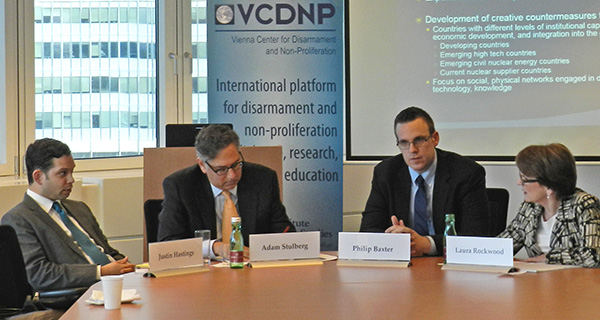
As part of its ongoing seminar series, on 16 November 2015, the VCDNP hosted an event on “Technology and Knowledge Transfer in Nuclear Proliferation Networks”, with presentations by Adam Stulberg (Professor and Co-Director, Sam Nunn School of International Affairs, Georgia Institute of Technology), Justin Hastings (Senior Lecturer, Department of Government and International Relations, University of Sydney) and Philip Baxter (Senior Research Associate, James Martin Center for Nonproliferation Studies, Washington, DC).

The event highlighted the challenges that illicit nuclear trafficking poses for international security and the current lack of proper understanding as to how proliferation networks are organized and run. The researchers sought to address these challenges, using the case studies of North Korean, Iranian and Pakistani proliferation networks to inform the development of tools for the visualization and analysis of illicit nuclear proliferation. The researchers presented their preliminary findings and sought to provide some early policy and analytical implications of their work.
Dr. Stulberg provided an overview of the team’s three-year research effort. In assessing the networks they uncovered, three key research questions were posed: to what extent is the network international; what are the characteristics of the network (such as its nature and structure); and what is the network’s socio-political context.
Dr. Hastings noted that all the data that had been gathered was open-source, and although far from perfect, not insufficient for analysis. Among other lines of enquiry, the researchers looked at the level of globalization of transit countries—i.e. those countries through which nuclear material and/or radioactive sources would pass—and the level of congruence between the nationality of whichever group was under consideration as compared with those transit states.
One finding Hastings stressed in particular was that nuclear material (as opposed to radioactive sources) tends to move through less globalized countries and that, as the level of globalization increases, transfers seem to shift away from nuclear material and toward radioactive sources. Hastings also observed that the data had revealed that the more secure the country of origin, the more international any group looking to smuggle nuclear material will be: in other words, better security changed the nature of the threat being faced to one more global and more sophisticated in nature.
Hastings also discussed some of the team’s preliminary findings in relation to their case studies, including that Iran had tended to rely heavily on Iranian brokers using simple routes, legal means of transport and the UAE as a transit hub. North Korea has historically made much use of masking strategies and non-North Korean brokers.
Baxter discussed the team’s efforts to assess the level of “tacit” knowledge in Iran and Pakistan, defined by for purposes of their research project as knowledge that is difficult to acquire, transfer and foster, that is gained mostly through experience and experimental training, and—crucially for the team’s work—that is diffused through networks. To gain data on such knowledge, the team had scoured online academic databases to assess state capacity, institutional capacity and personal and institutional exchanges and linkages over time in both Iran and Pakistan. Building up a picture of such knowledge networks—which the team argued they had managed to do to a robust standard—is then able to inform assessments including the timeframe between nuclear programs being set in motion, and tacit knowledge filtering through the academic and scientific communities in the two countries targeted for study.
Stulberg concluded with an overview of possible policy dimensions emerging from the research. This included the distinctions between those networks trafficking in nuclear material and those trafficking in radioactive sources, and the correlations referred to above as to the nature of the threat relative to the level of nuclear security preparedness.
Several avenues for further research were identified by the presenters, including: a study applying the systematic methodology developed by them to the tracking of militarily significant nuclear technology; expansion of the study to currently emerging nuclear energy states; and a detailed look at what countermeasures could be put in place around the world, taking into account countries having different levels of capacity, technological and economic development, and varying degrees of integration into the global economy.
